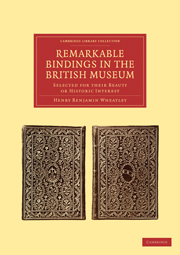Book contents
- Frontmatter
- PREFACE
- Contents
- INTRODUCTION
- I DEPARTMENT OF MANUSCRIPTS
- II DEPARTMENT OF MANUSCRIPTS
- III DEPARTMENTS OF MANUSCRIPTS AND PRINTED BOOKS
- IV DEPARTMENT OF PRINTED BOOKS
- V DEPARTMENT OF PRINTED BOOKS
- VI DEPARTMENT OF PRINTED BOOKS
- VII DEPARTMENT OF PRINTED BOOKS
- TABLE
- BOOKBINDING CONSIDERED AS A FINE ART, MECHANICAL ART, AND MANUFACTURE
- PREFACE
- CONTENTS
- HISTORY OF BOOKBINDING
- BINDING AS A FINE ART
- BINDING AS A MECHANICAL ART
- BINDING AS A MANUFACTURE
- PRACTICAL POINTS CONNECTED WITH BINDING
- APPENDIX
- DISCUSSION
- CATALOGUE OF SPECIMENS OF BINDING LENT FOR EXHIBITION
- LIST OF ENGRAVINGS
- Plate section
- Plate section
- Plate section
HISTORY OF BOOKBINDING
Published online by Cambridge University Press: 05 March 2012
- Frontmatter
- PREFACE
- Contents
- INTRODUCTION
- I DEPARTMENT OF MANUSCRIPTS
- II DEPARTMENT OF MANUSCRIPTS
- III DEPARTMENTS OF MANUSCRIPTS AND PRINTED BOOKS
- IV DEPARTMENT OF PRINTED BOOKS
- V DEPARTMENT OF PRINTED BOOKS
- VI DEPARTMENT OF PRINTED BOOKS
- VII DEPARTMENT OF PRINTED BOOKS
- TABLE
- BOOKBINDING CONSIDERED AS A FINE ART, MECHANICAL ART, AND MANUFACTURE
- PREFACE
- CONTENTS
- HISTORY OF BOOKBINDING
- BINDING AS A FINE ART
- BINDING AS A MECHANICAL ART
- BINDING AS A MANUFACTURE
- PRACTICAL POINTS CONNECTED WITH BINDING
- APPENDIX
- DISCUSSION
- CATALOGUE OF SPECIMENS OF BINDING LENT FOR EXHIBITION
- LIST OF ENGRAVINGS
- Plate section
- Plate section
- Plate section
Summary
I feel that it is a great privilege to be allowed an opportunity of treating some points in the history of Bookbinding from this place, and I think that the subject is one particularly appropriate for consideration before the Society of Arts, as the several aspects in which the art may be looked at are in unison with more than one of the objects of the Society.
Bookbinding may be considered as a Fine Art, as a Mechanical Art, and as a Manufacture, but, before dealing with these divisions of the subject, it will be well to take a rapid survey of the history of the art. It is not necessary to dive into the recesses of antiquity, and to bring to the surface the name of the ancient Phillatius–inventor of a particular kind of glue for fastening the leaves of a book together, to whom, the Athenians are said to have erected a statue as the founder of the art of binding–for Bookbinding, as we now understand it, is essentially a modern art. So to deal largely with the numerous materials used at various times for the covering of books–such as terra-cotta, wood, ivory, metal-work, needlework, &c.–would carry us far away from the subject we have to consider.
The goldsmiths, the silversmiths, the enamellers, the ivory carvers, and many other artists not ordinarily associated in our minds with book production, all united to adorn the precious manuscripts of ancient times; so that St. Jerome was forced to exclaim, “Your books are covered with precious stones, and Christ died naked before the gate of his Temple.”
- Type
- Chapter
- Information
- Remarkable Bindings in the British MuseumSelected for their Beauty or Historic Interest, pp. 149 - 158Publisher: Cambridge University PressPrint publication year: 2010First published in: 1889



